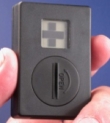California startup CliniSense has developed a small sensor that can calculate if a perishable shipment has spoiled due to temperature variations. Currently, the device uses an LCD screen to indicate a product’s freshness, but the company is looking for partners to license its technology to make a version integrated with an RFID tag.
“This technology covers a broader range of device and market niches than we can handle as a startup,” says Stephen E. Zweig, CEO at CliniSense, which is based in Los Gatos, Calif.
The battery-operated CliniSense LifeTrack sensor measures temperatures from -20 degrees Celsius to 70 degrees Celsius. The image on its LCD screen changes from a plus sign to a negative sign to indicate when a fresh shipment has spoiled. The key part of the sensor design, however, is the onboard processor that calculates how much the product has degraded as a result of exposure to various temperatures.
The 1-by-2-inch device, which has 4 kilobytes of on-board memory, can be set to take temperature readings at regular periods that range from one per minute to one per hour. A temperature coefficient table specific to the goods being monitored can be uploaded to the sensor by the user. The sensor uses the upload coefficient table to calculate what effect a product’s temperature history would have on that product.
According to CliniSense, most of the sensor’s targeted customers such as pharmaceutical companies and companies delivering MRE to the military have already routinely developed the temperature coefficient tables for their products as part of the product design process. These tables need only to be in Microsoft Excel spreadsheet format in order to be loaded onto the LifeTrack sensor.
CliniSense maintains that by having the processing capability on board, its sensors can be used to immediately identify spoiled shipments. “Prior to the LifeTrack sensor, there have been two ways of reading a temperature log of a shipment. Either download data from a sensor to an external source such as a network or pore over the log data and decide if the shipment is still good,” says Zweig.
The LifeTrack sensor has an infrared port that can be used to download data such as an abbreviated temperature log to a PC or PDA. CliniSense said it opted to build in infrared and not RFID because of the maturity of the infrared technology. “Infrared is less research intensive than RFID, which has many different flavors and standards,” says Zweig.
In addition to having an infrared port, the sensor has an input-output port to enable an RFID tag or other device to be attached. According to CliniSense, adding RFID would provide a way for users to download product temperature history and freshness status without line of sight, as required by the infrared port. Adding RFID also promises to cut the size and cost of the LifeTrack sensor, which is currently priced at around $20 each.
CliniSense also says that it has recently been awarded U.S. patents for the methodology employed by its sensors to use temperature coefficients.


